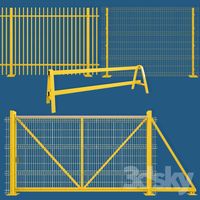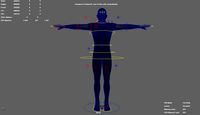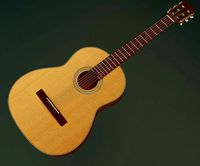GrabCAD

Classic Escapement - Recoil (Common)
by GrabCAD
Last crawled date: 1 year, 10 months ago
This project is based on the book CLOCK AND WATCH ESCAPEMENT MECHANICS by Mark V. Headrick (Copyright 1997) as a fine source. The book is public (http://www.nawcc-index.net/Articles/Headrick-EscMechanics.pdf), so you can read and compare (with the book) everything I present here. Actually, you can use my projects as accurate simulations for understanding the book. I recommend you download the book in order to use it when your computer is offline.
All parts, assemblies, and simulations/animation are made with Inventor 2014, so some specific references are bonded to this software.
As you can learn from the book, there are three classical kinds of escapement mechanisms: Graham (dead-beat), Recoil, and the Swiss Lever. My former projects present the Graham (dead-beat) escapement, and now I present the Recoil escapement. This project is explained in the book on page 16. The difference from the Graham escapement is that the wheel has also a backward movement, not only forward. This is due to the fact that the left arm of the palette has no positive effect - to feed the pendulum with energy - but to push back the wheel. This effect can be interpreted as a recoil like someone would coil the clock's spring, isn't it? That way a small part of the energy of the pendulum is returned to the reel. The problem is a loss of accuracy since the backward movement is somehow difficult to control.
There are some variants of the Recoil escapement. Here is presented the most common one, where the pallet looks like a bent bar. The design of the mechanism is based on the design of the Graham (Ideal) escapement, as seen in the pictures on page 16 of the book. Included in my project is the „Basic Sketch.jpg” picture. Here you can see the important halves of the active lines from the Graham (Ideal) design - the ones dimensioned 3°. In the book is written, „Shorten the entry pallet slightly and move the exit pallet slightly outwards, parallel to the impulse face of the Graham exit pallet”. The enter pallet is the left arm, and the exit is the right one. That „slightly” shorten and move are dimensioned by me as 2.5 mm, and respectively 2 mm.
The pallet is created and you can see that the mass center is a bit eccentric (Classic Escapement - Recoil (Common) - Palette.jpg). To reduce the eccentricity a characteristic dimension of the left arm was reduced to 60 mm.
Again, if you use Inventor (2014, 2015...), by entering Environments / Dynamic Simulation you can make your settings to change the way the system works. For instance, you can change the torque applied on the reel from 6 N mm to another value. You can also change the length of the rod from 400 mm. Watch what happens and try other values till you obtain a stable, uniform movement, of the pendulum for a long period of time.
To see some real construction look here:
Rudimentary: https://youtu.be/pOie2rMdN6k (little recoil)
Professional adjustment of the entrance drop: https://youtu.be/Q6hC31fEN2I (noticeable recoil)
All parts, assemblies, and simulations/animation are made with Inventor 2014, so some specific references are bonded to this software.
As you can learn from the book, there are three classical kinds of escapement mechanisms: Graham (dead-beat), Recoil, and the Swiss Lever. My former projects present the Graham (dead-beat) escapement, and now I present the Recoil escapement. This project is explained in the book on page 16. The difference from the Graham escapement is that the wheel has also a backward movement, not only forward. This is due to the fact that the left arm of the palette has no positive effect - to feed the pendulum with energy - but to push back the wheel. This effect can be interpreted as a recoil like someone would coil the clock's spring, isn't it? That way a small part of the energy of the pendulum is returned to the reel. The problem is a loss of accuracy since the backward movement is somehow difficult to control.
There are some variants of the Recoil escapement. Here is presented the most common one, where the pallet looks like a bent bar. The design of the mechanism is based on the design of the Graham (Ideal) escapement, as seen in the pictures on page 16 of the book. Included in my project is the „Basic Sketch.jpg” picture. Here you can see the important halves of the active lines from the Graham (Ideal) design - the ones dimensioned 3°. In the book is written, „Shorten the entry pallet slightly and move the exit pallet slightly outwards, parallel to the impulse face of the Graham exit pallet”. The enter pallet is the left arm, and the exit is the right one. That „slightly” shorten and move are dimensioned by me as 2.5 mm, and respectively 2 mm.
The pallet is created and you can see that the mass center is a bit eccentric (Classic Escapement - Recoil (Common) - Palette.jpg). To reduce the eccentricity a characteristic dimension of the left arm was reduced to 60 mm.
Again, if you use Inventor (2014, 2015...), by entering Environments / Dynamic Simulation you can make your settings to change the way the system works. For instance, you can change the torque applied on the reel from 6 N mm to another value. You can also change the length of the rod from 400 mm. Watch what happens and try other values till you obtain a stable, uniform movement, of the pendulum for a long period of time.
To see some real construction look here:
Rudimentary: https://youtu.be/pOie2rMdN6k (little recoil)
Professional adjustment of the entrance drop: https://youtu.be/Q6hC31fEN2I (noticeable recoil)
Similar models
3dwarehouse
free

Recoil Clock Escapement
...ly and move the exit pallet slightly outwards, parallel to the impulse face of the graham exit pallet. #clock #escapement #recoil
grabcad
free

Classic Escapement - Recoil (Brocot)
...looking to the remarkable simulation of ken kuo, and reading the documented description here: https://youtu.be/vh1rh6wgv60
enjoy!
grabcad
free

Classic Escapement - Graham (Modified)
...see an increase of the amplitude of palette oscillation. this can be adjusted by changing the length of the pendulum rod.
enjoy!
grabcad
free

Classic Escapement - Graham (Ideal)
... the other way is to manually insert the joints, and entering/leaving the dynamic simulation seems to be more complicated.
enjoy!
grabcad
free

Classic Escapement - Swiss Lever
....be/heas0l1jans
watch kinematic chain: https://youtu.be/dao0mbabnle
ultimate swiss creation: https://youtu.be/mqjfrt-2hdk
enjoy!
grabcad
free

Classic Escapement - Graham (BHI)
...dead beat escapement. the rest of the details are similar to my mentioned projects (both ideal and modified). however,...
3dwarehouse
free

Clockwork Graham Escapement SketchyPhysics
...differ. the length of the pendulum regulates the period of oscillation (tick-tock). the different lengths give different periods.
thingiverse
free

Parametric Graham Escapement by syvwlch
...cad, and plan to eventually build up to a full clock. i'm amazed by how far, how fast i got with openscad, btw, it rocks! :-)
grabcad
free

Escapement MacDowall (305)
... two constructions, you cannot stop thinking: „i wonder if i can simulate these so simple things with my beloved cad software...”
grabcad
free

Escapement - non slip pawls solution
...inventor 2014 and the resulting animation was obtained by using dynamic simulation module included in inventor professional 2014.
Recoil
turbosquid
$30

Solar lamp recoil hanger with fold out silicon lens
...nger with fold out silicon lens for download as ige and sldas on turbosquid: 3d models for games, architecture, videos. (1493640)
humster3d
$75

3D model of Bad Boy Buggies Recoil iS 4×4 2012
...el of bad boy buggies recoil is 4×4 2012 in various file formats. all our 3d models were created maximally close to the original.
3d_export
free

special forces
...forces 3dexport i tried animation in “magicaxoxel”: automatic rifle recoil movement of the bolt handle, bullet casing. here is...
3d_ocean
$15

Luger P08 (Parabellum)
...the pistole parabellum 1908—or parabellum-pistole (pistol parabellum)—is a toggle-locked recoiloperated semi-automatic pistol. the design was patented by georg j....
3d_export
$41

Stylized Hand painted Pistol
...rigged. the objects are: barrel magazine magazinerelease grip hammer recoil spring plug safety lever slide slide stop ---texture information---...
3d_export
$138

Stylized PBR 4 sniper Pack Series
...to be rigged. the objects are: magazinerelease grip hammer recoil spring plug safety lever slide slide stop this model...
renderosity
$8

Recoil
...listic depth mapping and lighting. ads were rendered in poser pro 2012. body shape is from skintime 2.0 by darkworld,</p>
3d_sky
free

Gates recoiling
...gates recoiling
3dsky
sliding gates, metal
thingiverse
free

Recoil Lug Alignment Tool by Greazybill
...il lug square when installing a rem/age barrel on a remington 700. using a wheeler action wrench and factory remington recoil lug
thingiverse
free

1911 Recoil buffer by PrintedFirearm
...y posted by steakfarmer on grabcad. check out this design and more on my blog: http://www.printedfirearm.com/1911-recoil-buffer/
Escapement
turbosquid
$10

Fire Escape
...osquid
royalty free 3d model fire escape for download as max on turbosquid: 3d models for games, architecture, videos. (1406933)
turbosquid
$1

Fire Escape
...quid
royalty free 3d model fire escape for download as blend on turbosquid: 3d models for games, architecture, videos. (1568818)
turbosquid
free

Fire Escape
... available on turbo squid, the world's leading provider of digital 3d models for visualization, films, television, and games.
turbosquid
free

Escape Signs
... available on turbo squid, the world's leading provider of digital 3d models for visualization, films, television, and games.
design_connected
$18

Escape Sun Lounger
...escape sun lounger
designconnected
cane-line escape sun lounger computer generated 3d model.
turbosquid
$1

Escape sports car
...odel escape sports car for download as jpg, 3ds, obj, and md3 on turbosquid: 3d models for games, architecture, videos. (1500588)
turbosquid
$29

Fire Escape Stairs
... available on turbo squid, the world's leading provider of digital 3d models for visualization, films, television, and games.
turbosquid
$12

ROYAL ESCAPE CRAFT
... available on turbo squid, the world's leading provider of digital 3d models for visualization, films, television, and games.
turbosquid
free

escape bay.3DS
... available on turbo squid, the world's leading provider of digital 3d models for visualization, films, television, and games.
3d_ocean
$89

Ford Escape 2012
...y, in real units of measurement, qualitatively and maximally close to the original. model formats: - *.max (3ds max 2008 scanl...
Common
turbosquid
$5

Common birch
...squid
royalty free 3d model common birch for download as max on turbosquid: 3d models for games, architecture, videos. (1710340)
turbosquid
$9

Common Trees
...ree 3d model common trees for download as blend, fbx, and obj on turbosquid: 3d models for games, architecture, videos. (1619165)
turbosquid
$100

Common Plane
... available on turbo squid, the world's leading provider of digital 3d models for visualization, films, television, and games.
turbosquid
$5

Common Flashlight
... available on turbo squid, the world's leading provider of digital 3d models for visualization, films, television, and games.
turbosquid
$5

common tree
... available on turbo squid, the world's leading provider of digital 3d models for visualization, films, television, and games.
turbosquid
free

common pen
... available on turbo squid, the world's leading provider of digital 3d models for visualization, films, television, and games.
3d_export
$5

common birch
... is 3.6meters. the archive has 2 formats fbx and obj. this model supports the program 3 ds max version 2019, and vray version 3.2
turbosquid
$2

Common person RIGGED
...
royalty free 3d model common person rigged for download as on turbosquid: 3d models for games, architecture, videos. (1681017)
turbosquid
$25

Common Suede Sneakers
...model common suede sneakers for download as obj, fbx, and dae on turbosquid: 3d models for games, architecture, videos. (1410545)
3ddd
$1

MOOOI Common Comrades
...
- merchant
- scholar
- seamstress
- tailor
дизайнер: neri & hu
размеры: h400mm х 400mm x 400mmhttp://www.moooi.com
Classic
3ddd
$1

classic mirror
...classic mirror
3ddd
classic mirror for classic interior design
3d_ocean
$19

Classic curtains
...classic curtains
3docean
architectural classic classical curtains decoration details drapes
classic curtains 3d max2011 fbx obj
3d_ocean
$12

classic watch
...classic watch
3docean
classic old watch
quality model classic watches
3d_export
$5

classic tools
...classic tools
3dexport
classic tools for modern and classic spaces inlaid carving
3d_export
$5

classic tools
...classic tools
3dexport
classic tools for modern and classic spaces inlaid carving
3d_export
$5

classic tools
...classic tools
3dexport
classic tools for modern and classic spaces inlaid carving
turbosquid
$50

classic
...turbosquid
royalty free 3d model classic for download as max on turbosquid: 3d models for games, architecture, videos. (1182819)
turbosquid
$20

classic
...turbosquid
royalty free 3d model classic for download as 3ds on turbosquid: 3d models for games, architecture, videos. (1346242)
3d_export
$25

classic guitar
...classic guitar
3dexport
the classical guitar is a member of the guitar family used in classical music.
3d_ocean
$19

Sofa classic
...
3docean
classic classical couch design furnishings furniture interior sofa style traditional
sofa classic max2011 fbx obj unwrap
